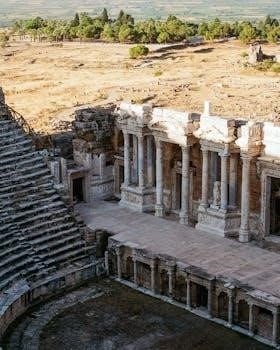AP World History Exam PDF⁚ A Comprehensive Guide
Embark on your AP World History journey with confidence! This guide unveils the power of the AP World History Exam PDF, your key to mastering content and acing the exam․ Discover resources, practice tests, and strategies, all designed to elevate your preparation․
Overview of the AP World History Exam
The AP World History⁚ Modern exam is a comprehensive assessment designed to evaluate your understanding of global historical developments from c․ 1200 CE to the present․ It tests not only your knowledge of key events and figures but also your ability to analyze historical evidence, construct arguments, and understand diverse perspectives․ This challenging exam requires thorough preparation and a strategic approach․
The exam is structured to assess your grasp of major themes, including interactions between societies, the development of state structures, economic systems, social organizations, and cultural and intellectual movements․ Familiarity with broad patterns and themes in world history, such as political structures and social transformations, is crucial for success․
Many students find the AP World History course demanding but rewarding, as it offers a chance to explore the vast tapestry of human history․ The exam emphasizes specific events and periods, helping students develop analytical skills applicable to new facts and historical integration․ By understanding the exam’s format and content, you can effectively prepare and demonstrate your mastery of world history․
Exam Format and Structure
The AP World History⁚ Modern Exam is designed to comprehensively evaluate your understanding of world history from 1200 CE to the present․ The exam is divided into two sections, each contributing significantly to your final score․ Section I consists of multiple-choice questions and short-answer questions (SAQs), while Section II includes a document-based question (DBQ) and a long essay question (LEQ)․
Section I is further divided into two parts⁚ Part A features multiple-choice questions that assess your knowledge of historical facts and your ability to analyze primary and secondary sources․ Part B includes short-answer questions that require you to provide concise and focused responses to specific prompts․
Section II challenges you to demonstrate your analytical and writing skills․ The DBQ requires you to construct an argument using provided documents, while the LEQ asks you to develop a thesis-driven essay based on your understanding of a given historical topic․ The exam is timed, totaling 3 hours and 15 minutes, so pacing and time management are essential strategies for success․
Multiple-Choice Section Details
The Multiple-Choice section of the AP World History exam is designed to assess your grasp of historical knowledge, analytical skills, and ability to interpret historical sources․ This section constitutes a significant portion of your overall score, demanding thorough preparation and strategic test-taking․

Expect a variety of question types, including those that require you to identify factual information, understand cause-and-effect relationships, analyze historical trends, and interpret primary and secondary source excerpts․ Questions may cover a broad range of topics, reflecting the course’s chronological scope from 1200 CE to the present․ Geographic literacy is also crucial, as questions often require you to understand the spatial context of historical events․
To succeed in this section, focus on building a strong foundation of historical knowledge, practicing analytical skills, and familiarizing yourself with different types of source materials․ Effective strategies include active reading, note-taking, and regular review of key concepts and events․ Also, practice with sample questions to familiarize yourself with the exam’s format and difficulty level․ Time management is also key․
Short-Answer Question (SAQ) Strategies
The Short-Answer Question (SAQ) section of the AP World History exam tests your ability to concisely and accurately respond to specific historical prompts․ Mastering this section requires a blend of content knowledge, analytical skills, and effective writing․
Each SAQ typically presents a focused question related to a particular historical period, event, or theme․ Your response should directly address the prompt, providing clear and concise answers supported by specific historical evidence․ Avoid broad generalizations or vague statements․ Instead, demonstrate your understanding of the topic by citing relevant facts, events, and concepts․
Effective SAQ responses follow a clear structure⁚ answer the question directly, provide specific evidence to support your answer, and explain how the evidence relates to the prompt․ Aim for a well-organized response that demonstrates your understanding of the historical context and your ability to analyze and synthesize information․ Practice writing SAQs regularly, focusing on clarity, conciseness, and accuracy․ Review sample responses and scoring guidelines to understand what graders are looking for․ Time management is also crucial․

Document-Based Question (DBQ) Analysis
The Document-Based Question (DBQ) is a crucial component of the AP World History exam, testing your ability to analyze historical documents and construct a well-supported argument․ This section requires you to synthesize information from a variety of sources and present your own interpretation of historical events․
Begin by carefully reading the prompt and understanding the historical context․ Then, thoroughly analyze each document, noting the author’s point of view, intended audience, and potential biases․ Look for connections and contradictions between the documents, and consider how they relate to the prompt․
Your essay should include a clear thesis statement that directly addresses the prompt․ Use the documents as evidence to support your argument, citing them appropriately․ Go beyond simply summarizing the documents; instead, analyze them critically and explain how they support your claims․ Also, incorporate outside knowledge to provide context and strengthen your analysis․ Remember to consider the limitations of the documents and potential missing perspectives․ Effective DBQ analysis demonstrates a deep understanding of historical context, analytical skills, and persuasive writing․
Long Essay Question (LEQ) Approaches

The Long Essay Question (LEQ) on the AP World History exam demands a comprehensive and well-structured response to a broad historical prompt․ Unlike the DBQ, the LEQ relies primarily on your prior knowledge and understanding of historical events and trends․
Start by carefully dissecting the prompt to identify the specific historical concepts and skills being assessed․ Develop a clear and concise thesis statement that directly answers the question and provides a roadmap for your essay․ Organize your essay into logical paragraphs, each focusing on a specific aspect of your argument․
Support your claims with specific historical evidence, demonstrating a deep understanding of the relevant time period and region․ Analyze the significance of the evidence and explain how it supports your thesis․ Consider different perspectives and interpretations of the historical events, and address potential counterarguments․ A strong LEQ demonstrates not only factual knowledge but also the ability to synthesize information, analyze historical trends, and construct a compelling argument․ Practice writing LEQs under timed conditions to improve your speed and accuracy․
Key Themes in AP World History
Mastering the AP World History exam requires familiarity with several overarching themes that recur throughout history․ These themes provide a framework for understanding global patterns and connections․ One crucial theme is the development and interaction of cultures, encompassing religious beliefs, philosophical ideas, and artistic expressions․ Analyze how cultures spread, adapt, and influence one another across different regions and time periods․

Another vital theme is the state-building, expansion, and conflict․ Examine the rise and fall of empires, the formation of nation-states, and the causes and consequences of wars and revolutions․ Economic systems and trade networks also play a significant role, shaping societies and driving global interactions․ Explore the impact of technological innovations on economic development and the environment․
Social structures, including gender roles, class hierarchies, and systems of slavery, are essential to understanding historical change․ Finally, human-environment interaction explores how humans have shaped and been shaped by the natural world․ Understanding these themes will allow you to analyze historical events from multiple perspectives․
Effective Study Strategies and Resources
To excel on the AP World History exam, implementing effective study strategies is crucial․ Begin by creating a structured study schedule, allocating specific time slots for each historical period and theme․ Break down the vast curriculum into manageable chunks, focusing on key concepts and events․ Utilize various study resources, including textbooks, review books, and online platforms, to gain a comprehensive understanding of the material․
Actively engage with the content by summarizing key points, creating flashcards, and participating in study groups․ Practice answering multiple-choice questions and free-response questions from past exams to familiarize yourself with the exam format and scoring criteria․ Seek feedback from teachers or peers on your essays to improve your writing skills․
Incorporate visual aids such as maps and timelines to enhance your understanding of historical geography and chronology․ Remember to prioritize sleep, nutrition, and stress management to optimize your cognitive function․ By combining effective study habits with high-quality resources, you can maximize your chances of success on the AP World History exam․
AP World History Cheatsheet PDF Overview
An AP World History cheatsheet PDF serves as a condensed yet powerful tool for exam preparation․ Imagine it as a meticulously crafted roadmap, highlighting the essential landmarks and crucial routes through centuries of global history․ This document isn’t meant to replace thorough study; rather, it’s designed to consolidate your knowledge, providing a quick reference for key concepts, dates, and turning points․
Typically, a well-structured cheatsheet will organize information by major historical periods and themes, offering concise summaries of significant events, political structures, social developments, and cultural transformations․ You’ll find key terms defined, important figures identified, and overarching trends explained in a succinct manner․ The goal is to jog your memory and provide a framework for recalling more detailed information during the exam․
Think of it as your mental springboard, enabling you to swiftly access and apply your accumulated knowledge․ Remember, the cheatsheet is most effective when used in conjunction with comprehensive study and practice․ It’s the perfect companion for quick reviews, last-minute refreshers, and solidifying your understanding of the big picture․
Utilizing Practice Tests and Past Papers
Practice tests and past papers are invaluable assets in your AP World History exam preparation arsenal․ These resources offer a realistic simulation of the actual exam environment, allowing you to familiarize yourself with the question formats, time constraints, and content areas covered․ By engaging with practice materials, you can identify your strengths and weaknesses, pinpointing areas that require further study and refinement․
When utilizing practice tests, treat them as genuine exams․ Adhere to the time limits, minimize distractions, and avoid consulting external resources․ After completing the test, meticulously review your answers, paying close attention to the rationale behind each correct and incorrect response․ Analyze your mistakes to understand the underlying concepts you need to reinforce․
Past papers, in particular, provide insights into the exam’s evolving trends and the types of questions commonly asked․ By studying these papers, you can anticipate the exam’s demands and develop effective strategies for tackling different question types, including multiple-choice, short-answer, document-based questions (DBQs), and long essay questions (LEQs)․ Remember, consistent practice and thorough review are key to maximizing the benefits of these resources․
Understanding the AP World History Curriculum Framework
To excel in the AP World History exam, a firm grasp of the curriculum framework is crucial․ This framework acts as the blueprint for the entire course, outlining the key concepts, historical periods, and themes that will be assessed․ By understanding its structure and content, you can tailor your study efforts to align with the exam’s expectations․
The curriculum framework is organized around specific historical periods, each with its own set of learning objectives and essential knowledge․ Familiarize yourself with the chronological order of these periods and the major events, developments, and interactions that shaped them․ Pay attention to the key themes that run throughout the course, such as the development of states, cultural interactions, economic systems, and social structures․
Furthermore, the framework emphasizes historical thinking skills, which are essential for analyzing and interpreting historical evidence․ These skills include sourcing, contextualization, argumentation, and comparison․ By developing these skills, you’ll be able to engage with historical sources critically and construct well-supported arguments in your essays․
